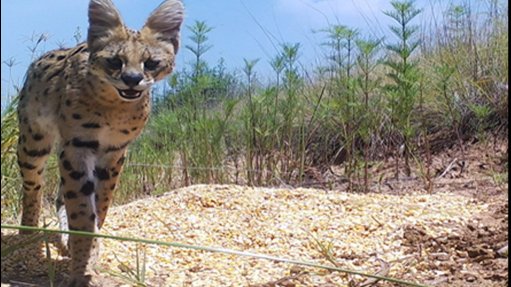
Anglo American Coal’s Isibonelo Colliery is emerging as a noteworthy case study for how rehabilitated landscapes can play an important role in conservation and biodiversity, including a ground-breaking study on the population of serval in the Mpumalanga coalfields.
Isibonelo is home to a large number of species, including otter, water mongoose, bush pig, porcupine, spotted genet, common duiker and even the Red-listed brown hyena.
Serval, a midsized wild cat species, is particularly abundant on rehabilitated land in the area.
Together with the African Institute for Conservation Ecology and Genetics, the mine has embarked on a five-year research project for wildcat and wetland specialists to investigate the persistence of this species in modified landscapes.
The study will include an estimation of the site’s serval population size, feeding ecology and behavioural adaptations. Activity is monitored by remotely activated cameras and Global Positioning System collars.
To date, 148 individual servals have been identified on the mine’s 2 000 ha site, which Anglo American Coal rehabilitation superintendent Roze Reiners says is a fairly high density for the species.
The study, to be registered as a project with the Mpumalanga Tourism and Parks Agency, is being overseen by University of Venda senior researcher Dr Lourens Swanepoel.
Field work will be conducted by student ecologists from the University of Venda and the University of the Free State.
“While research and public perception generally focus on mining’s negative impact on fauna and flora, scientists are starting to understand how unused and rehabilitated landscapes can create unique environments that have an important role to play in conservation,” says Reiners.
Monitoring is initially being conducted on selected portions of mine property and will be followed by a broad-spectrum study over a 75 km radius to comparatively measure the impacts of mining and agriculture on the species.
The process of DNA testing to check the bloodlines of the population will start in July.
Reiners points out that the high population of serval points to the presence of a sustainable food source for the species. Serval primarily feed on rats and mice and do not pose a threat to livestock, as many farmers mistakenly believe.
“The value of modified industrial landscapes is slowly emerging as a theme in academic and conservation circles. We believe this study will greatly improve our knowledge on the conservation value of modified industrial landscapes for various species and that these should be considered in future conservation planning,” says Reiners.